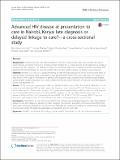Advanced HIV Disease at Presentation to Care in Nairobi, Kenya: Late Diagnosis or Delayed Linkage to Care--a Cross-sectional sSudy
View/
Publication Date
2016-04-18Type
Article, Journalviews
downloads
Metadata
Show full item recordCitation
van der Kop, M. L., Thabane, L., Awiti, P. O., Muhula, S., Kyomuhangi, L. B., Lester, R. T., & Ekström, A. M. (2016). Advanced HIV disease at presentation to care in Nairobi, Kenya: late diagnosis or delayed linkage to care?--a cross-sectional study. BMC infectious diseases, 16, 169. https://doi.org/10.1186/s12879-016-1500-8
Abstract/
Background Presenting to care with advanced HIV is common in sub-Saharan Africa and increases the risk of severe disease and death; however, it remains unclear whether this is a consequence of late diagnosis or a delay in seeking care after diagnosis. The objectives of this cross-sectional study were to determine factors associated with advanced HIV at presentation to care and whether this was due to late diagnosis or delays in accessing care. Methods Between 2013 and 2015, adults presenting to care were recruited at two clinics in low-income areas of Nairobi, Kenya. Participants were considered to have advanced HIV if their CD4 count was below 200 cells/μL, or they were in WHO stage 4. Information on previous HIV diagnoses was collected using interviewer-administered questionnaires. Logistic regression was used to determine the association between clinical and socio-demographic factors and advanced HIV. Results Of 753 participants presenting to HIV care, 248 (33 %) had advanced HIV. Almost 60 % (146/248) of those presenting with advanced HIV had been previously diagnosed, most of whom (102/145; 70 %) presented to care within three months of their initial diagnosis. The median time to presentation to HIV care after an initial diagnosis was 22 days (IQR 6-147) for those with advanced HIV, compared to 19 days (IQR 4-119) for those with non-advanced HIV (p = 0.716). Clinic (adjusted odds ratio [AOR] 1.55, 95 % CI 1.09–2.20) and age (AOR 1.72 per unit increase in age category, 95 % CI 1.45–2.03) were associated with presenting with advanced HIV. Conclusions Presentation to care with advanced HIV was primarily due to delayed diagnosis, rather than delayed linkage to care after diagnosis. Variation by clinic suggests that outreach and other community-based efforts may drive earlier testing and linkage to care. Our findings highlight the ongoing importance of implementing strategies to encourage earlier HIV diagnosis, particularly among adults 30 years and older.
Subject/
HIV/AIDS; Sub-Saharan Africa; Kenya; Advanced HIV; Presentation to HIV carex; Presentation to HIV care; Informal settlements
Further Details
© 2016 van der Kop et al. Open Access This article is distributed under the terms of the Creative Commons Attribution 4.0 International License (http://creativecommons.org/licenses/by/4.0/), which permits unrestricted use, distribution, and reproduction in any medium, provided you give appropriate credit to the original author(s) and the source, provide a link to the Creative Commons license, and indicate if changes were made. The Creative Commons Public Domain Dedication waiver (http://creativecommons.org/publicdomain/zero/1.0/) applies to the data made available in this article, unless otherwise stated.
Publisher
BMCCollections
- General - GEN [367]

